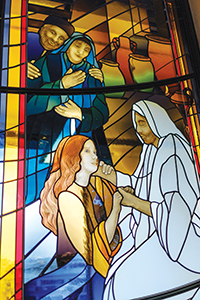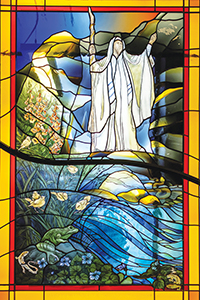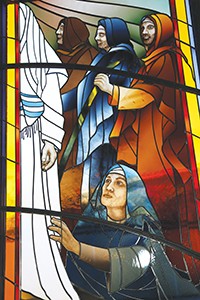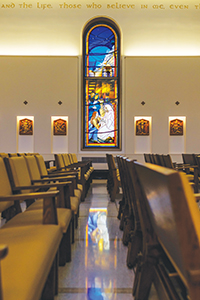By KATHLEEN NELSON
AMITA Health Resurrection Medical Center Chicago recently completed restoration of its chapel with the installation of seven art glass windows depicting images of healing from scripture. Their messages have struck an emotional chord with visitors, said Darren Henson, who was AMITA's vice president of mission and discernment, during the restoration.

One of seven stained glass windows commissioned for the chapel at AMITA Health Resurrection Medical Center Chicago. Stephen Serio
"They're astounded," he said. "You can see the amazement in their eyes and hear them say 'wow' under their breath."
The windows are the crown jewels and finishing touch on a renovation necessitated by a fire in December 2014 that destroyed most of the chapel. The restoration project was funded through insurance and private donations.
At the time of the fire, Resurrection Medical Center was part of Chicago-based Presence Health. St. Louis-based Ascension acquired Presence in March 2018 and made Presence a part of AMITA Health, a joint operating company of Ascension and AdventHealth system of Altamonte Springs, Fla.

Henson
Shortly after the fire, Presence Health formed a chapel renovation advisory committee. It engaged Fr. Mark Joseph Costello, OFM Cap, a liturgical consultant with background in the design of sacred spaces, to advise them on the architectural guidelines of the Second Vatican Council and the United States Conference of Catholic Bishops.
Bridging past and future
"We wanted to envision very intentionally what a chapel in a Catholic hospital should look like in the 21st century," said Henson, who left AMITA May 31.
The committee started almost from scratch. The monumental crucifix was removed for refurbishing along with the marble from the altar and the Stations of the Cross before the chapel was gutted.
Only one of the original seven stained glass windows remained intact after the fire, an image of St. Margaret Mary Alacoque. (St. Margaret Mary was a 17th century nun and mystic who promoted devotion to the Sacred Heart of Jesus.) The other windows were broken in the effort to put out the fire.
Henson said the windows "spoke to the spirituality" of the Sisters of the Resurrection, the hospital's founding sponsors.
The original windows on one side of the chapel depicted Mary; the other side featured images of Christ at his resurrection and as king. They were replaced temporarily with clear glass. The image of St. Margaret was reinstalled on the back wall of the chapel.
Healing art
Through discussions with the sisters, Fr. Costello and system leadership, the idea emerged to replace the clear glass windows with stained glass images of healing. The committee created a list of Gospel and Old Testament stories with healing and restorative imagery and distributed the list to staff, the sisters, nurses, spiritual leaders, even the regulars at Mass. With their input, the committee narrowed the list to 10.
The committee took those stories to the artists they had chosen to interview. From three finalists, they selected Kathy Barnard, who specializes in etched glass and has a studio in Kansas City, Mo. Barnard developed sketches for the 10 stories, from which she and the committee settled on seven:
- Moses and the Bronze Serpent: Numbers 21:4 – 9
- Elijah and the Widow's Only Son: 1 Kings 17:1 – 24
- The Man Born Blind: John 9:1 – 41
- The Hemorrhaging Woman: Luke 8:43 – 48; Matthew 9:18 – 26; Mark 5:21– 43.
- Jairus' Daughter: Mark 5:21– 43; Matthew 9:18 – 26; Luke 8:40 – 56
- The Good Samaritan: Luke 10:25 – 37
- Washing of the Feet: John 13:1 – 15
Design coherence
To create design cohesion, Barnard incorporated into the windows elements from other parts of the chapel, such as the gold stars and blue background on the ceiling and the band of amber used as an outline around the altar. The blue glass in each of the side wall windows forms a free-form arc through each set of three windows, gradually flowing upward to heaven in the windows closest to the altar.

Moses and the Bronze Serpent
Stephen Serio

The Hemorrhaging Woman
Mitchell Solomon
"I don't need people to be hit over the head with what everything means at once," Barnard said. "I want them to discover something different every time they go in there."
She worked with a glass company in Germany, flying there to approve the exact coloring of the glass, which was shipped to her studio in sheets. Working with two assistants, Barnard created patterns, then laid them on the glass. They cut the glass, then dry fit the pieces together before inserting lead between the fragments.
Barnard etched the title of each work into the window. The scripture citation and passage are in a plaque next to the window. She also experimented with a technique of painting faces on glass, then firing them in a kiln, rather than using stained glass to piece together a face.

Jairus’ Daughter
Stephen Serio
"I felt so confident with this group," she said of the restoration committee. "I was upfront and questioned them if they were willing to take the risk to take the painted glass and fire it in the kiln. It was a learning experience for all of us, and I think it turned out well."
Working through life's travails
Throughout the 18-month design process, Henson traveled to Kansas City to visit his ailing parents and to check on Barnard's progress. Barnard, who was tending to her ill mother, was grateful for the visits, as she and Henson shared their stories of caregiving as much as updates on the windows. "We talked about how the project helped us find healing, life and hopefulness through the difficulties we were facing at the time," Henson said.
After working on the windows in her relatively cramped studio, where they were stacked and leaned against a wall, Barnard and her crew traveled to Chicago to install the windows themselves.
"I thought I would be sad when the windows left my studio," she said. "But once they got in the chapel, you knew they belonged there. Being in the space and feeling the lines and color flow from when you walk in to the front, I was so happy to see them all together."
Henson said he knows from personal experience and from observing visitors to the chapel that the windows and the stories they tell "can be a source of healing, hope and comfort for our patients and their families. You can see it and feel it anytime you're there."